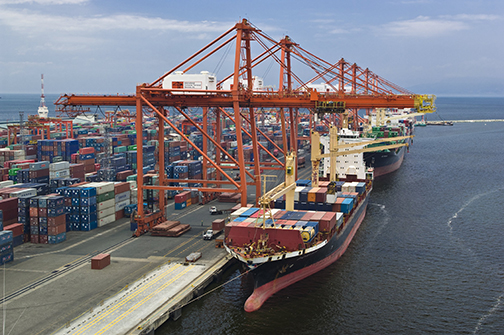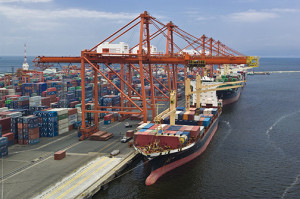

Conditions at Manila’s two international terminals continue to improve significantly in the past weeks after the Manila truck ban was lifted indefinitely mid-September this year.
At the Manila International Container Terminal (MICT), the situation has “dramatically improved” in the last week and a half, according to Christian Gonzalez, vice president and head for Asia Region of International Container Terminal Services, Inc during his presentation at the Port Users Confederation Ports Summit on Nov 17.
With yard utilization now around 84%, he noted this is “extremely low for this time of year.”
Import inventory has also gone down to between 17,000 and 22,000 twenty-foot-equivalent units (TEUs) from 20,000 to 30,000 TEUs during the Manila daytime truck ban.
Gonzalez said means containers are getting out of the port and “less people are getting affected by storage, which is good.”
“I think that the penalty imposed by PPA (Philippine Ports Authority) is working very well,” he noted. As part of government measures to decongest Manila ports, PPA levied higher storage rates to force owners of overstaying cargoes to pull out shipments and avoid using the terminals as virtual warehouses.
Gonzalez said MICT’s problem right now is “clearing the vessel queue.”
He noted that when the truck ban was lifted indefinitely in September, “congestion in the yard and vessel queue (had become) so severe that it made it very, very difficult to make headway in reducing that backlog.”
Compounding the issue of vessel arrivals, according to Gonzalez, is that vessels now calling at MICT are bigger, since they are carrying more backlog shipments, cargoes for the peak season, and stocks of importers meant for the end of the year and the first quarter of next year.
Some vessels calling MICT have a capacity of 2,000 TEUs, which requires nearly doubling moves per vessel to 1,400 from just 800 previously.
To alleviate the situation, Gonzalez said they have started using Berth 7 for repositioning of empties.
Operations at South Harbor have ‘stabilized’
Meanwhile, operations at the Manila South Harbor have “stabilized,” according to Ian Baking, Asian Terminals Inc. (ATI) assistant vice president for business development, during his presentation at the same Ports Summit.
Baking said the port has no vessel queues except for those that arrive out of schedule. Yard utilization is around 85% and drops to about 70% to 75% during Fridays, but increases to 90% to 95% after weekends due to low pull-outs.
Truck transactions have also improved 23% since lifting of the ban, and have increased to 13,990 transactions from October 1 to October 12 from 10,266 in the same period in September and 7,681 in August before the truck ban was lifted.
Baking said additional yards are now being developed to increase capacity by 10% by early next year.
As for Batangas Container Terminal, he said the port handled about 20,000 TEUs in October, 1,900% higher than the 1,000 TEUs handled last year. Ship calls also went up to 16 per week from one or two a week before the truck ban.
ATI earlier said volumes handled at the Batangas port rose 560% by end-September, four times higher than the 11,019.5 TEUs recorded during the full year of 2013.
Baking said ATI has enhanced information system at Batangas port to promote productivity and efficiency, and that additional developments will be implemented in the future.
Development of another port eyed
In his keynote speech during the Ports Summit, Transportation Secretary Joseph Emilio Abaya urged importers to utilize the weekend and holiday windows to pull out shipments to help further decongest ports.
He added that international shipping lines “should have enough depots for their empty containers.”
He said, “The government doesn’t have a clear handle or push button to regulate these international shipping lines, but they still have a role to play because if they’re not part of the solution, then they’re part of the problem.”
Other measures the government is looking into to decongest Manila ports includes developing another major port at the Manila Bay, probably at Sangley Point in Cavite or in Bataan province, and developing both the Subic Bay and Batangas ports to decentralize Manila.
Abaya said another possible short-term solution is to implement a truck appointment system by February next year as proposed by port operators.
Gonzalez, on the sidelines of the event, told PortCalls they are currently in talks with vendors for this system. – Roumina Pablo




